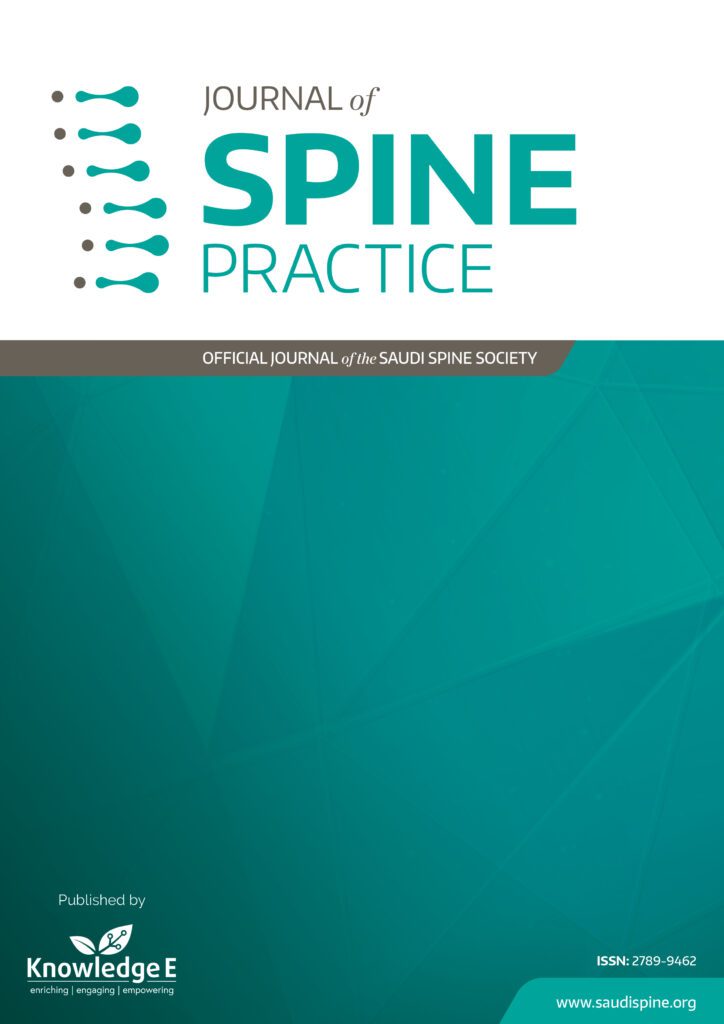
Journal of Spine Practice
ISSN: 2789-9462
Leading research in all spine subspecialties focusing on orthopaedic spine, neurosurgery, radiology, and pain management.
Association between cloacal exstrophy and two limited dorsal myeloschisis lesions: A case report and literature review
Published date: Jul 19 2022
Journal Title: Journal of Spine Practice
Issue title: Journal of Spine Practice (JSP): Volume 1, Issue 2
Pages: 75 - 82
Authors:
Abstract:
Background: The term limited dorsal myeloschisis (LDM) was coined by Pang in 1993. It involves incomplete obliteration of the dorsal neural fold in primary neurulation. On the other hand, Cloacal Exstrophy is one of the most complex endodermal anomalies and is usually associated with spinal anomalies; hence, the term OEIS complex was coined (Omphalocele, Exstrophy of the cloaca, Imperforate anus, and Spinal deformities complex).
Case Description: We report the coexistence of two LDM lesions in tandem (originating at L2 and S2 levels) in a child diagnosed with cloacal exstrophy. Initially, prenatal ultrasound detected the lumbar but not the sacral lesion. The patient was surgically untethered under intraoperative neurophysiologic monitoring (IOM) at four years of age, and this paper reports his one-year follow-up.
Conclusion: Cases of cloacal exstrophy must always be investigated for spinal cord malformations. LDM is rare and requires careful diagnosis. MRI should be done for the whole neuroaxis to rule out associated conditions, including multiplicity. Surgery should be done under IOM to avoid long-term complications.
Keywords: Limited dorsal myeloschisis, Tethered cord, Cloacal exstrophy, OEIS complex
References:
[1] Pang D, Dias MS. Cervical myelomeningoceles. Neurosurgery 1993; 33(3): 363–372; discussion 372–373.
[2] Morioka T, Murakami N, Suzuki SO, Takada A, Tajiri S, Shimogawa T, et al. Neurosurgical pathology and management of limited dorsal myeloschisis associated with congenital dermal sinus in infancy. Pediatr Neurosurg 2020; 55(2): 113–125.
[3] Kim KH, Wang KC, Lee JY. Enlargement of extraspinal cysts in spinal dysraphism: A reason for early untethering. J Korean Neurosurg Soc 2020; 63(3): 342–345.
[4] Pang D, Zovickian J, Oviedo A, Moes GS. Limited dorsal myeloschisis: A distinctive clinicopathological entity. Neurosurgery 2010; 67(6): 1555–1579; discussion 1579–1580.
[5] Pang D, Zovickian J, Wong ST, Hou YJ, Moes GS. Limited dorsal myeloschisis: A not-so-rare form of primary neurulation defect. Childs Nerv Syst 2013; 29(9): 1459–1484.
[6] Lee JY, Chong S, Choi YH, Phi JH, Cheon JE, Kim SK, et al. Modification of surgical procedure for ”probable” limited dorsal myeloschisis. J Neurosurg Pediatr 2017; 19(5): 616– 619.
[7] Morioka T, Suzuki SO, Murakami N, Shimogawa T, Mukae N, Inoha S, et al. Neurosurgical pathology of limited dorsal myeloschisis. Childs Nerv Syst 2018; 34(2): 293–303.
[8] Izci Y, Kural C. Limited dorsal myeloschisis with and without type I split cord malformation: Report of 3 cases and surgical nuances. Medicina 2019; 55(2): 28.
[9] Al-Salem AH. An illustrated guide to pediatric urology. New York: Springer; 2016.
[10] Kumar N, Chatur C, Balani A, Bisharat M, Tahir Z, Johal N, et al. Patterns of spinal cord malformation in cloacal exstrophy. J Neurosurg Pediatr 2021; 28(2): 1–8.
[11] Smith NM, Chambers HM, Furness ME, Haan EA. The OEIS complex (omphalocele-exstrophy-imperforate anusspinal defects): Recurrence in sibs. J Med Genet 1992; 29(10): 730–732.